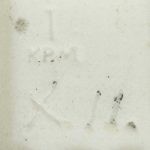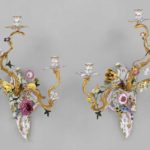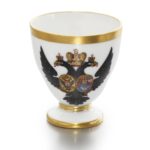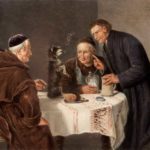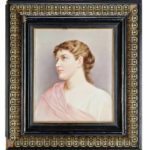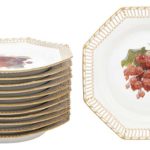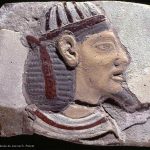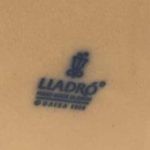The Royal Porcelain Factory in Berlin, also known as KPM for Königliche Porzellan-Manufaktur Berlin, was founded in 1763 by King Frederick II of Prussia (known as Frederick the Great). Its actual origins, however, lie in three private enterprises which, under crown patronage, were trying to establish the production of “white gold” (i.e. porcelain) in Berlin from the mid-18th century onwards. Porcelain from this factory are often called Berlin porcelain. Reference: Wikipedia
Below are some examples and price guides of Royal Porcelain Manufactory KPM antiques including an example of the KPM maker’s mark and a pair of wall lights.
Royal Porcelain Manufactory Berlin, KPM maker’s mark. Late 19th century
Pair of wall lights ca. 1765–68 Royal Porcelain Manufactory, Berlin
A specific characteristic of Frederick’s Rococo taste was a prominent use of naturalistic, boldly sculptural flowers. Those that dominate the design of this pair of wall lights are a hallmark of the Royal Porcelain Manufactory, which Frederick established in 1763 on acquiring a struggling porcelain factory. The wall lights, among the most ambi- tious objects made at the new factory, are brilliantly conceived as a pair. The back plates are mirror images, and many of the same flowers appear on both wall lights, on one depicted with the blossoms open and on the other with them closed. Among the flowers are peonies, tulips, carnations, roses, and columbine, and their modeling, whether in low relief or in three dimensions, represents a tour de force of porcelain production in the eighteenth century.
Reference: The Metropolitan Museum of Art
A Porcelain Ice Cup from the Grand Duke Paul Petrovich Service, Royal Porcelain Manufactory, Berlin, circa 1778 painted with a black double-headed eagle holding two shields, one painted with the armorials of the Russian empire, the other with the armorials of Holstein-Gottorp with blue scepter mark. the interior with label from the Exhibition of Russian Art, London, 1935. Height 2 5/8 in. 6.7 cm
The Berlin service was presented in 1775 by Frederick the Great of Prussia to Grand Duke Paul of Russia (later Paul I) whose father, Peter III, was Karl Friedrich, Duke of Holstein-Gottorp.
Sold for 10,625 USD at Sotheby’s in 2010
A KPM PORCELAIN PLAQUE Late 19th century Depicting monks and a smoking terrier, 19cm x 25cm, Impressed marks
Sold for £ 1,275 inc. premium at Bonham’s in 2019
A BERLIN (K.P.M.) PLAQUE LATE 19TH CENTURY, IMPRESSED SCEPTER AND KPM MARKS AND NUMERALS Painted with a bust-length portrait of a young lady, within an ebonised and brass mounted frame 11 ¾ X 12 ¾ in. (29.8 x 32.5 cm.) approx. including frame
Sold for GBP 1,500 at Christie’s in 2015
Assembled Set of Twelve KPM Hand-Painted Octagonal Reticulated Porcelain Fruit Plates Width 8 1/8 inches.
one plate appears to have had professional restoration to its badly damaged border and rim edge (purple grapes); one plate has a small flake paint loss to its painted fruit center (apple); the pate centers appear to be in generally very good, unscratched condition, however, one plate did show a small short scratch mark; three of the plates are marked in a different manner than the other plates; not artist signed; not blacklighted
Sold for $819 (includes buyer’s premium) at Doyle in 2021
